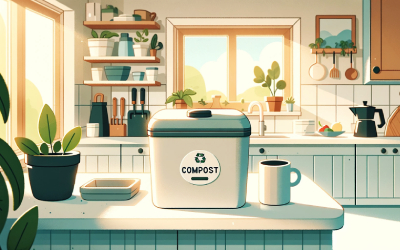
Small space composting: Vermicomposting, Bokashi composting, and traditional techniques
In the heart of bustling cities, amidst concrete jungles and high-rise living, a green revolution brews quietly in the corners of compact kitchens and cosy balconies. Urban gardeners, driven by a passion for sustainability and a love for gardening, are turning to small space composting as a way to reduce waste and nurture their green spaces. This guide is your golden ticket to mastering the art of small space composting indoors, ensuring that even the smallest apartment can contribute to a greener, healthier planet.
Advice from the experts 👩🌾
Use old glass jars for indoor composting, allowing you to observe the natural decomposition process while elegantly storing kitchen waste.
The basics of composting
Composting is nature's way of recycling organic matter. Microorganisms break down kitchen scraps, garden waste, and paper into nutrient-rich compost, a process that enriches the soil and reduces the need for chemical fertilisers. The core components of compost are green materials like vegetable scraps, rich in nitrogen, and brown materials like dry leaves, rich in carbon. The magic happens in the balance – maintaining a 1:3 ratio of green to brown materials ensures a smooth composting process, preventing odours and accelerating decomposition.

Methods of indoor composting
Vermicomposting: The Worm's Way
Imagine having a pet that takes your kitchen waste and turns it into black gold for your plants. That's vermicomposting for you! This method employs red wiggler worms to break down organic material in a contained bin. The worms work tirelessly, leaving behind castings that are incredibly nutrient-rich. An ideal setup includes a tiered bin, like The Worm Factory 360, allowing for easy separation of compost and continuous feeding. It's crucial to maintain a comfortable environment for the worms – a dark, temperate space with moist bedding and a balanced diet of your kitchen scraps.
Bokashi Composting: The Japanese Art of Fermentation
Bokashi composting is a standout method, especially for those who want to compost meat and dairy, typically no-nos in traditional composting. Originating from Japan, this technique involves fermenting organic waste in an airtight container using a specific mix of microorganisms. It's a swift process that doesn't emit foul odours, making it perfect for small, enclosed spaces. While it requires initial preparation, including sourcing Bokashi bran and setting up the bin, the payoff is quick and efficient composting, transforming your waste into a pre-compost matter that can be buried in soil or added to a traditional compost pile to finish the process.
Aerobic Composting: The Traditional Method
For those who prefer the traditional route, aerobic composting is a viable indoor option. It involves layering green and brown materials in a bin and ensuring adequate aeration to facilitate the breakdown process. Microorganisms thrive in this oxygen-rich environment, transforming your waste into compost over a few months. The key is to manage the balance and moisture level to prevent odours and pests. A small, well-designed compost bin can be tucked under the kitchen sink or sit neatly on the countertop, making composting accessible and unobtrusive.
Choosing the right composter for your space
The market is flooded with indoor composters, ranging from stylish countertop models to discrete under-counter systems. The choice hinges on your space, lifestyle, and the volume of waste you generate. For minimalists, a simple countertop bin with a charcoal filter might suffice, blending seamlessly with kitchen decor while controlling odors. Those with a bit more space might opt for an under-counter system with a glider shelf, combining convenience with capacity. Remember, the right composter not only fits your space but also your commitment to sustainable living.
Managing smells and pests
A balanced compost shouldn't smell bad. If it does, it's a sign that something is off. Too much moisture, excess food, or lack of aeration can lead to foul odours and attract pests. Add more brown materials to soak up excess moisture, cut back on the amount of waste you're adding, or aerate more frequently. A well-managed bin is a happy bin, contributing to a pleasant and pest-free home composting experience.

Using your compost
Once your compost is ready, it's time to let your plants feast on it. Use it for your indoor plants, balcony garden, or share it with community gardens. Composting is not just about reducing waste; it's about creating a cycle of growth and nourishment, where your waste becomes the lifeblood for new growth, encapsulating the beauty of sustainability.
If indoor composting seems daunting, explore community composting programs. Many cities offer services where you can drop off your compost or have it picked up. Some even provide financial incentives, like discounts on composting bins or tax breaks, to encourage this green practice. It's worth checking out what's available in your area – you might be pleasantly surprised.
And that's that! You're now ready to plan your own small space compost system. Happy harvesting!
